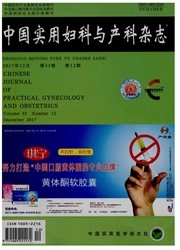

 中文摘要:
中文摘要:
目的探讨各种细胞遗传学产前诊断指征与胎儿染色体异常的关系。方法 2011年1月至2013年4月于重庆医科大学附属第一医院妇产科在知情同意的前提下,由超声引导对3495例孕中期高危孕妇(孕16-21+6周)行羊膜腔穿刺术,抽取适量羊水进行细胞培养及染色体核型分析。比较不同产前诊断指征与胎儿染色体异常核型检出率的关系。结果羊水培养成功3494例,成功率99.97%。检出异常核型120例,异常率为3.43%(120/3494),其中染色体数目异常70例,结构异常31例,其他异常19例。各种产前诊断指征中,单纯高龄(分娩时孕妇年龄≥35岁)1498例,检出异常核型47例,异常检出率为3.14%;母血清学筛查高风险1560例,异常核型38例,检出率2.44%;无创产前DNA检测高风险38例,异常核型30例,检出率78.95%,后者检出率分别与前两者相比差异有统计学意义(P〈0.05)。结论掌握好各种产前诊断指征,对高危孕妇进行羊膜腔穿刺及染色体核型分析可有效提高胎儿染色体病的检出率,减少出生缺陷的发生。
 英文摘要:
英文摘要:
Objective To explore the relationship between fetal chromosomal abnornmlity and various prenatal diagnosis indications. Methods After obtaining informed consents, amniocentesises were implemented with the guidance of ultrasound in 3495 second trimester pregnant women at high risk (16-21+6W). Amniotic fluids were extracted and amniotic fluid exfoliated cells were cultured and harvested for chromosome karyotype analysis. The relationship between various prenatal diagnosis indications and fetal chromosomal karyotype abnormality was analyzed. Results Totally 3494 cases of amniotic fluid cell were successfully cultured and the success rate was 99.97%.A total of 120 cases of abnormal karyotypes were detected and the abnormality rate was 3.43% (120/3494), including 70 cases of chromosome number abnor- malities, 31 cases of chromosome structural abnormalities and 19 cases of other abnormalities. In various prenatal diagnosis indications, 47 cases were found with abnormal karyotypes in 1498 cases of advanced birth maternal age(≥35 years), the abnormal rate was 3.14%;there were 38 cases in 1560 cases of Down's high-risk, the rate was 2.44%;there were 30 cases in 38 cases of high risk in non-invasive fetal trisomy test, the rate was 78.95%. Compared with the advanced birth maternal age and Down' s high-risk, the rate of abnormal karyotypes in high risk in non-invasive fetal trisomy test was of significant difference(P〈0.05). Conclusion The combination of various prenatal diagnosis indications for amniocentesis and amniotic fluid cell chromosome karyotype analysis in high-risk pregnant women can effectively improve the detection rate of fetal chromosomal disease and reduce the incidence of birth defects.
 同期刊论文项目
同期刊论文项目
 同项目期刊论文
同项目期刊论文
 The expression of pentraxin 3 and tumor necrosis factor-alpha is increased in preeclamptic placental
The expression of pentraxin 3 and tumor necrosis factor-alpha is increased in preeclamptic placental IL-27 activates human trophoblasts to express IP-10 and IL-6: implications in the immunopathophysiol
IL-27 activates human trophoblasts to express IP-10 and IL-6: implications in the immunopathophysiol 期刊信息
期刊信息
